A Symmetry-Driven Broadband Circularly Polarized Magnetoelectric Dipole Antenna with Bandpass Filtering Response
Abstract
1. Introduction
2. Antenna Design
2.1. Antenna Configuration
2.2. Step-by-Step Design Process
2.3. Analysis of Radiation Nulls and Axial Ratio Performance
3. Antenna Implementation
4. Conclusions
Author Contributions
Funding
Data Availability Statement
Conflicts of Interest
References
- Mao, C.; Khalily, M.; Tafazolli, R.; Kishk, A. Wideband Dual Circularly Polarized Helical Antenna Array for Satellite Applications. IEEE Antennas Wirel. Propag. Lett. 2024, 9, 2758–2762. [Google Scholar] [CrossRef]
- Hou, R.; Ren, J.; Liu, Y.-T.; Cai, Y.-M.; Wang, J.; Yin, Y. Broadband Magnetoelectric Dipole Filtering Antenna for 5G Application. IEEE Antennas Wirel. Propag. Lett. 2023, 3, 497–501. [Google Scholar] [CrossRef]
- Li, L.; Xiong, H.D.; Wu, W.Y.; Fu, A.B.; Han, J.Y. A T-Shaped Strips Loaded Wideband Filtering Patch Antenna With High Selectivity. IEEE Antennas Wirel. Propag. Lett. 2024, 1, 89–93. [Google Scholar] [CrossRef]
- Zhao, Z.; Qiu, L.-F.; You, B.; Wu, L.-S.; Mao, J.-F. Three-Dimensional Integrated Circularly Polarized Filtering Antenna Array With High-Efficiency Hybrid Feeding Network. IEEE Trans. Antennas Propag. 2024, 8, 6348–6361. [Google Scholar] [CrossRef]
- Li, J.-F.; Lin, Y.-Q.; Xue, Y.-M.; Ye, L.-H.; Mao, C.-X. A Shared-Aperture Linearly/Circularly Polarized Filtering Antenna Array With Low Profile. IEEE Antennas Wirel. Propag. Lett. 2024, 11, 3877–3881. [Google Scholar] [CrossRef]
- Xiang, K.-R.; Chen, F.-C.; Xue, Q.; Chu, Q.-X. A High-Selectivity Circularly Polarized Filtering Antenna Based on Wavefront Phase Compensation. IEEE Antennas Wirel. Propag. Lett. 2024, 10, 3307–3311. [Google Scholar] [CrossRef]
- Paul, V.; Dhwaj, K. A Reflectionless Circularly Polarized High-Gain Microstrip Filtering Antenna With Wideband Response. IEEE Trans. Antennas Propag. 2024, 6, 5384–5389. [Google Scholar] [CrossRef]
- Wu, Q.-S.; Tang, X.-Y.; Du, Z.-X.; Zhang, X. An all-metal wideband circularly polarized single-patch antenna based on TM11 mode. IEEE Trans. Antennas Propag. 2023, 10, 8266–8271. [Google Scholar] [CrossRef]
- Wu, S.; Li, J.; Yao, J.; Cao, Y.; Yan, S. 3-D Printed Millimeter-Wave Filtering Monopulse Comparator for Dual-Circularly Polarized Antenna. IEEE Antennas Wirel. Propag. Lett. 2024, 12, 4797–4801. [Google Scholar] [CrossRef]
- Hu, Y.; Wu, Y.; Wang, G.; Wu, X. A Circularly Polarized, Highly Selective, Harmonic-Suppressed Filtering Antenna for 5G Application. IEEE Antennas Wirel. Propag. Lett. 2024, 12, 4308–4312. [Google Scholar] [CrossRef]
- Liu, S.; Wang, Z.; Dong, Y. A Compact Filtering Patch Antenna With High Suppression Level and Its CP Application. IEEE Antennas Wirel. Propag. Lett. 2023, 4, 769–773. [Google Scholar] [CrossRef]
- Xu, T.; Li, J.-F.; Ye, L.-H.; Wu, D.-L.; Zhang, G. A Wideband Circularly Polarized Filtering Patch Antenna With Strip Network. IEEE Antennas Wirel. Propag. Lett. 2023, 12, 2826–2830. [Google Scholar] [CrossRef]
- Jia, Q.S.; Zhang, W.H.; Han, X.; Huang, Y.M.; Ding, S.; Wang, B.Z.; Bozzi, M. A Broadband Filtering Circularly Polarized Folded Transmitarray Antenna Based on Metasurface. IEEE Antennas Wirel. Propag. Lett. 2023, 10, 2357–2361. [Google Scholar] [CrossRef]
- Hu, H.-T.; Chan, K.F.; Chan, C.H. Low-Profile Circular-Polarized Filtering Transmitarray Antenna in V-Band. IEEE Antennas Wirel. Propag. Lett. 2024, 1, 938–943. [Google Scholar] [CrossRef]
- Hu, H.-T.; Chan, K.F.; Chan, C.H. High-Gain Dual-Circular-Polarized Filtering Lens Antenna for Low-Cost 60 GHz Applications. IEEE Antennas Wirel. Propag. Lett. 2024, 2, 828–832. [Google Scholar] [CrossRef]
- Yang, W.J.; Pan, Y.M.; Zhang, X.Y. A Single-Layer Low-Profile Circularly Polarized Filtering Patch Antenna. IEEE Antennas Wirel. Propag. Lett. 2021, 4, 602–606. [Google Scholar] [CrossRef]
- Cheng, G.; Huang, B.; Huang, Z.; Yang, L. A High-Gain Circularly Polarized Filtering Stacked Patch Antenna. IEEE Antennas Wirel. Propag. Lett. 2023, 5, 995–999. [Google Scholar] [CrossRef]
- Wang, J.; Zhang, Y.; Ye, L.; Liu, Q.H. A Wideband Circularly Polarized Filtering Antenna Based on Slot-Patch Structure. IEEE Antennas Wirel. Propag. Lett. 2023, 8, 1858–1862. [Google Scholar] [CrossRef]
- Cheng, G.; Zhou, J.; Yang, L.; Wu, X.; Huang, Z. A Stacked Circularly Polarized Filtering Antenna With Crossed Slot. IEEE Antennas Wirel. Propag. Lett. 2023, 12, 2935–2939. [Google Scholar] [CrossRef]
- Zhou, J.; Pan, X.; Cheng, G.; Yang, L.; Li, Y.; Huang, Z. A Wideband Circularly Polarized Filtering Antenna Based on Multilayer Structural Design. IEEE Antennas Wirel. Propag. Lett. 2024, 11, 3887–3891. [Google Scholar] [CrossRef]
- Xiao, Z.; Cao, Y.; Che, W.; Xue, Q. Millimeter-Wave Filtering Circularly Polarized Antenna Using Hybrid Radiation Modes for Satellite Applications. IEEE Antennas Wirel. Propag. Lett. 2024, 11, 7584–7593. [Google Scholar] [CrossRef]
- Tang, M.-C.; Li, D.; Wang, Y.; Hu, K.-Z.; Ziolkowski, R.W. Compact, Low-Profile, Linearly and Circularly Polarized Filtennas Enabled With Custom-Designed Feed-Probe Structures. IEEE Trans. Antennas Propag. 2020, 7, 5247–5256. [Google Scholar] [CrossRef]
- Cahyasiwi, D.A.; Zulkifli, F.Y.; Rahardjo, E.T. Orthogonal Resonators for Circularly Polarized Filtering Antenna Using a Single Feedline. IEEE Trans. Microw. Theory Tech. 2023, 10, 4227–4235. [Google Scholar] [CrossRef]
- Lin, X.J.; Zhang, Y.; Qiu, Z.L.; Huang, Z. A Compact Circularly Polarized Filtering Dipole Antenna With Co-Layered Printed Ring Structures. IEEE Antennas Wirel. Propag. Lett. 2024, 10, 3098–3102. [Google Scholar] [CrossRef]
- Wei, S.Z.; Zhou, Z.; Tang, Z.; Yin, J.Y.; Ren, J.; Yin, Y. Broadband Filtering Magnetoelectronic Dipole Antenna With Quasi-Elliptic Gain Response. IEEE Trans. Antennas Propag. 2020, 4, 3225–3230. [Google Scholar] [CrossRef]
- Feng, B.; Chen, J.; Chung, K.L.; Wang, L.; Li, Y. Dual-Polarized Filtering Magneto-Electric Dipole Antenna Arrays With High Radiation-Suppression Index for 5G New Radio n258 Operations. IEEE Trans. Antennas Propag. 2022, 4, 3058–3063. [Google Scholar] [CrossRef]

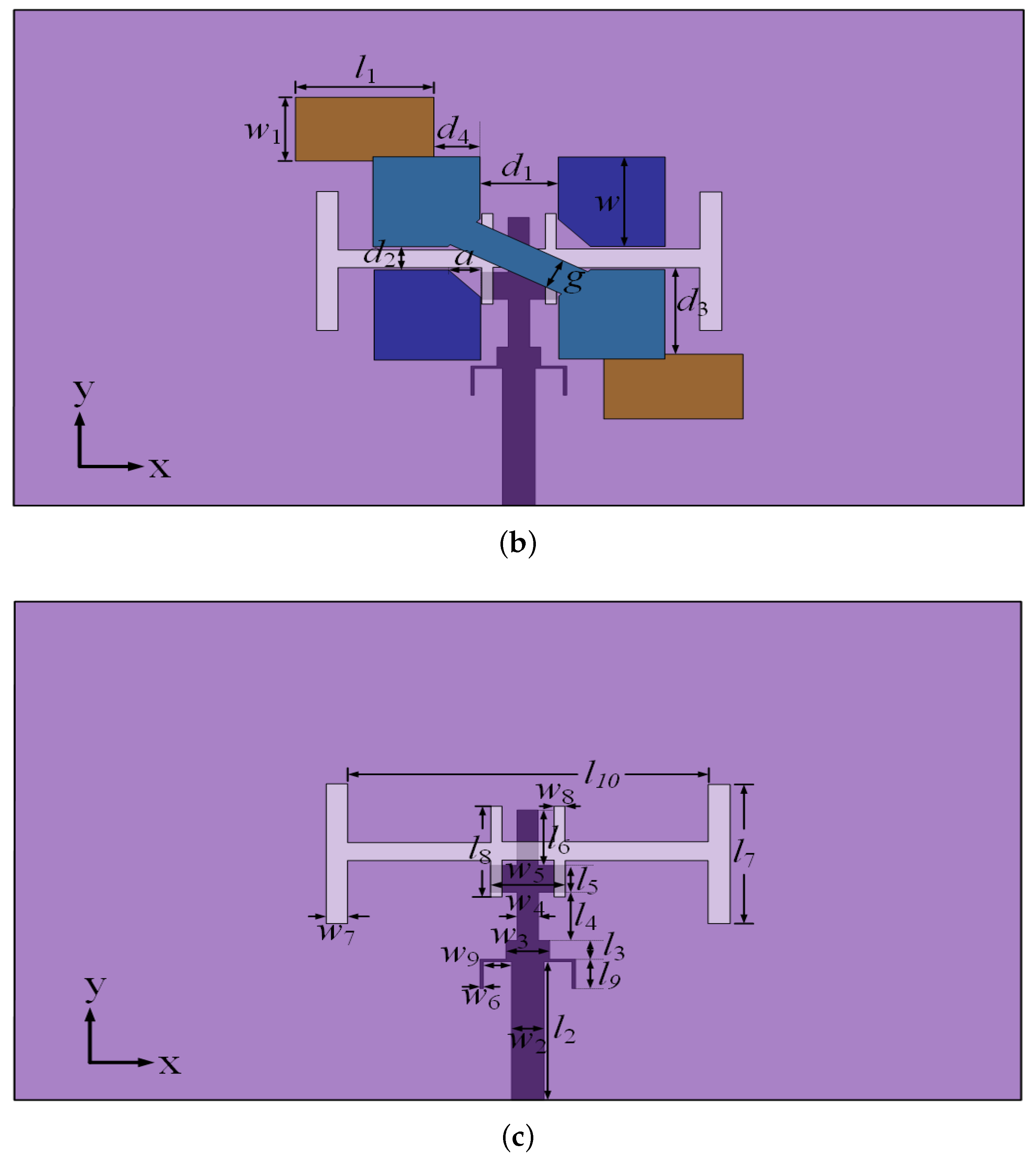

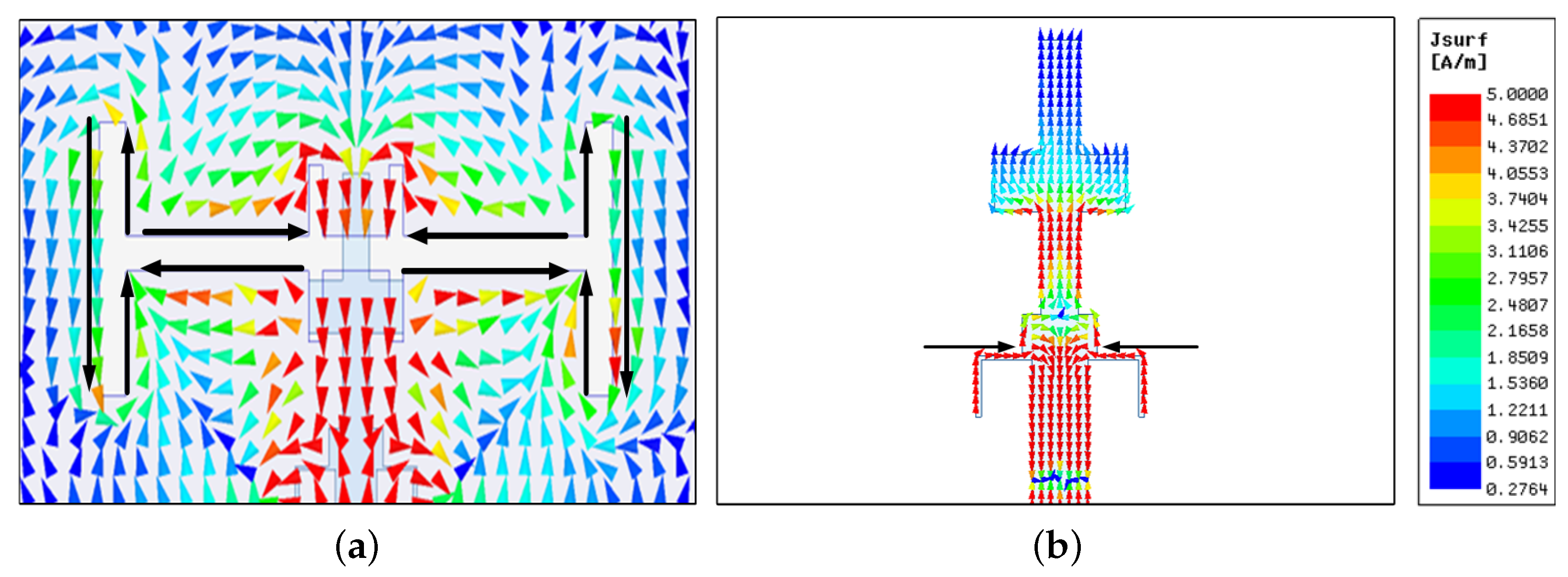
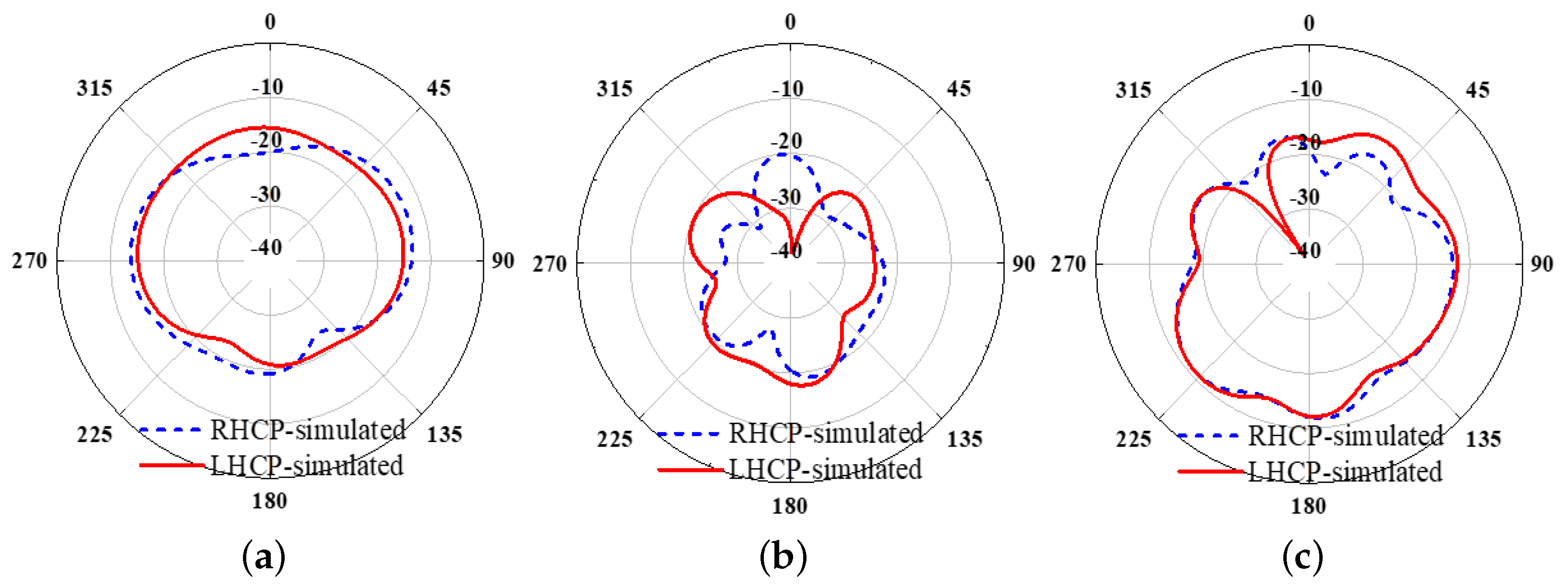
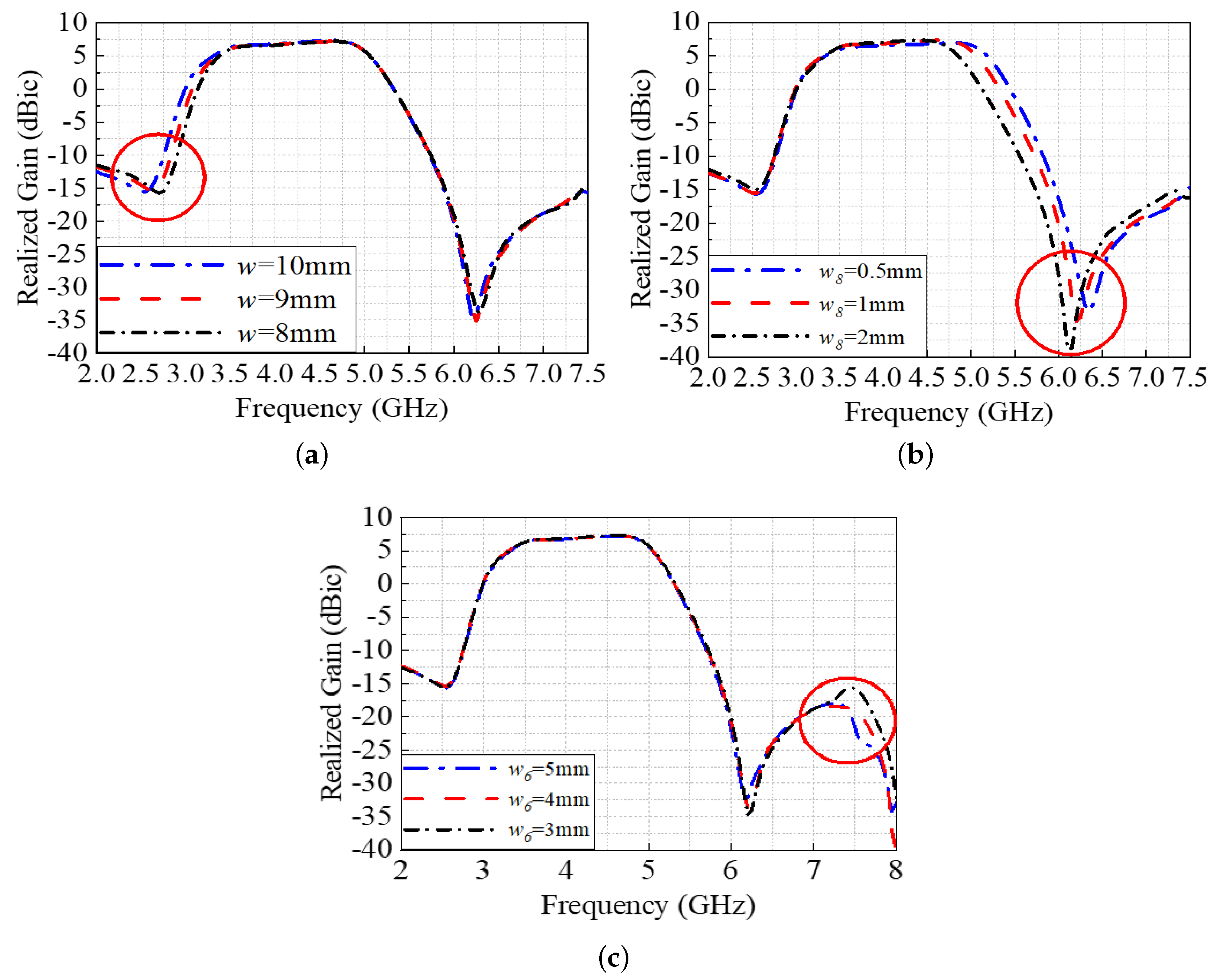
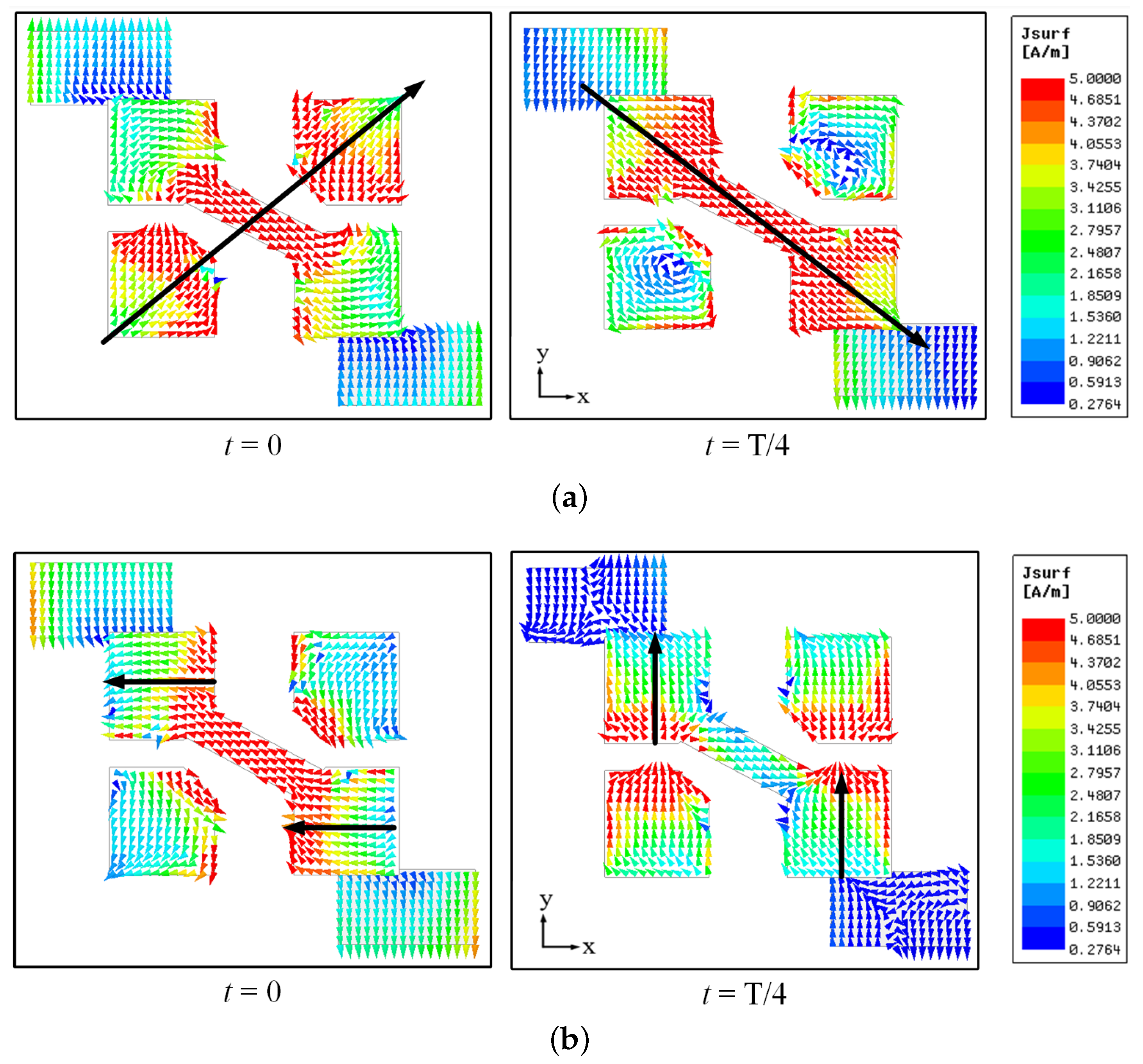

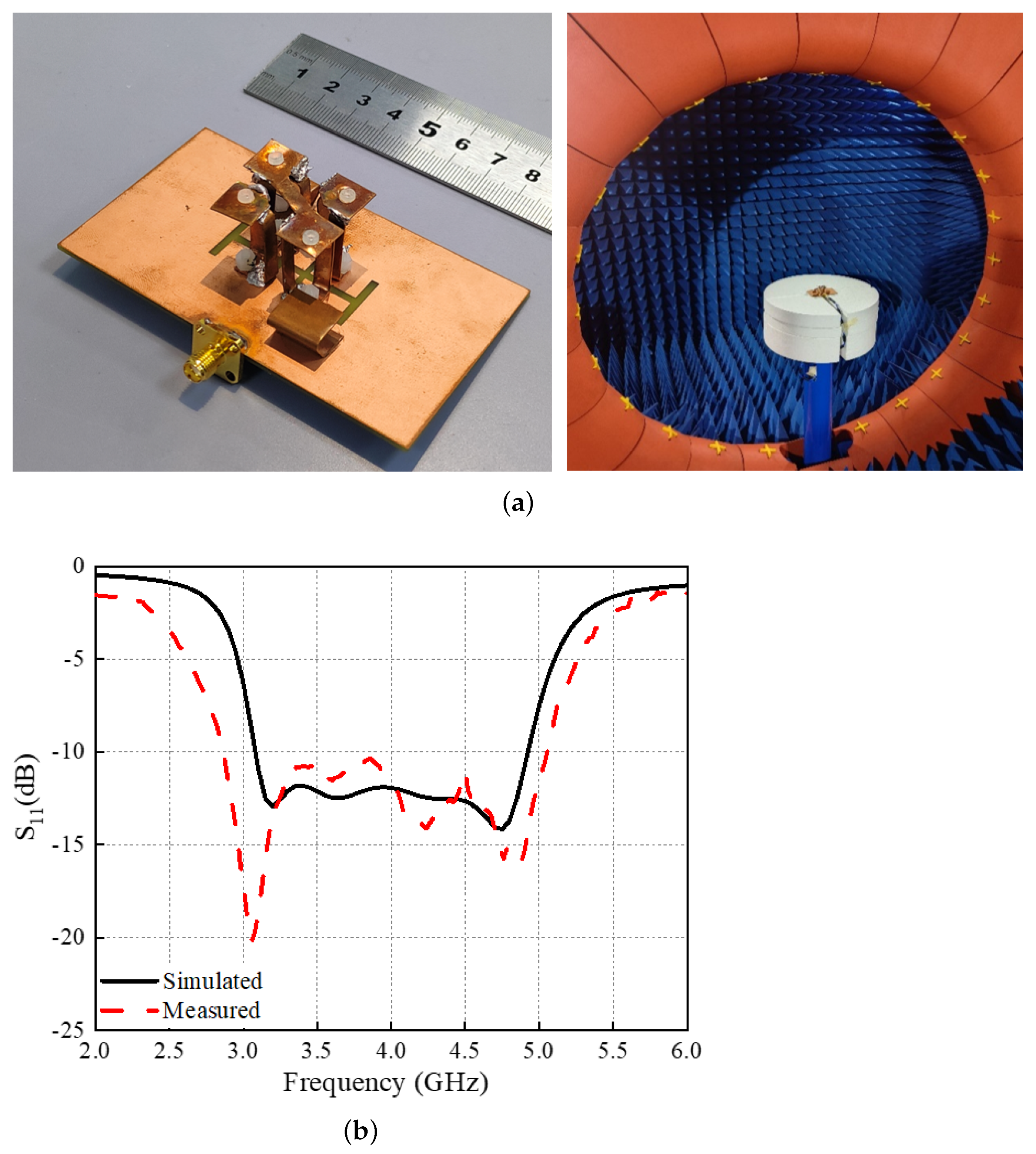

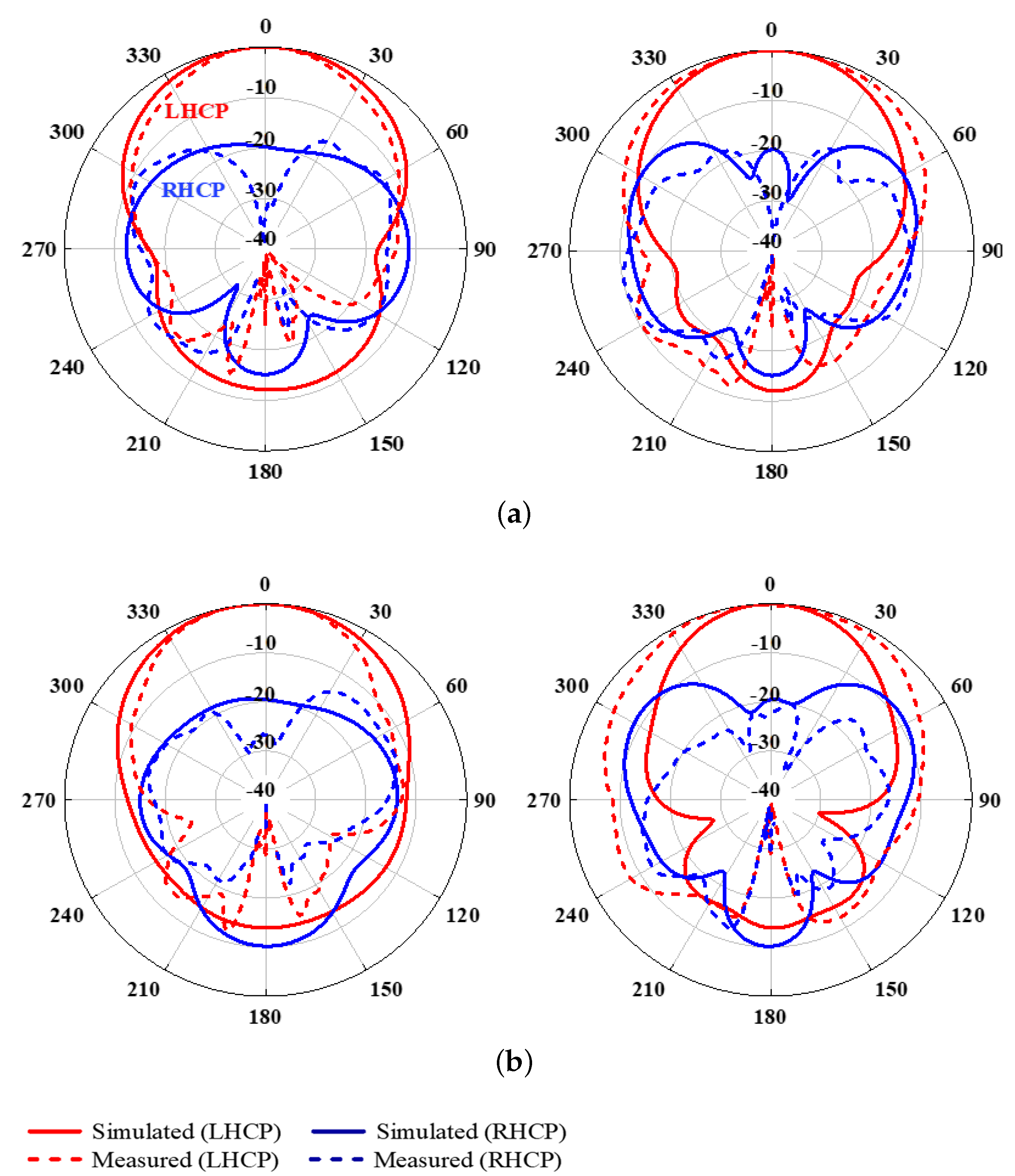
| Ref. | Size () | Filtering Methods | Imp./ AR. BW (%) | Ave Gain (dB) | Sup. (dB) | GSI/RSI |
|---|---|---|---|---|---|---|
| [10] | 1.11 × 1 × 0.039 | Filtering phase shifter | 7.10%/7.09% | 5.4 | 28.7/ 26.9 | 0.892/ N/A |
| [11] | 1.55 × 0.9 × 0.058 | Filtering phase shifter | 11.40%/14.29% | 7.86 | 24.11/ 25.92 | 0.694/ 0.71 |
| [12] | 0.97 × 0.97 × 0.07 | Filtering phase shifter | 21.60%/23.10% | 6.5 | 23/ 14 | 0.626/ N/A |
| [16] | 0.92 × 0.92 × 0.01 | Parasitic patch | 4.5%/5.3% | 7.5 | 22.5/ 24.5 | 0.65/ N/A |
| [17] | 0.52 × 0.52 × 0.06 | Slot | 15.20%/8.20% | 6.8 | 26.8/ 28.2 | 0.73/ N/A |
| [18] | 0.71 × 0.71 × 0.31 | Slot | 58.30%/46.9% | 7.6 | 13.6/ 10.1 | 0.855/ N/A |
| [19] | 0.59 × 0.47 × 0.1 | Parasitic patch + Slot | 17.72%/9.32% | 6.3 | 20/ 21 | 0.645/ N/A |
| [20] | 0.51 × 0.51 × 0.26 | Shorting pin + Slot | 59.00%/51.80% | 7.0 | 18.08/ 15.89 | 0.934/ 0.57 |
| [21] | 1.53 × 1.53 × 0.19 | Shorting patch + Open stub | 15%/16.40% | 13.0 | 14/ 16 | 0.821/ N/A |
| [22] | 0.38 × 0.38 × 0.025 | Open stub | 7%/4.5% | 6 | 26/ 20 | 0.916/ 0.44 |
| [23] | 0.7 × 0.7 × 0.024 | Two coupled resonators | 4.70%/3.20% | 5.5 | 31/ 31 | 0.804/ N/A |
| [24] | 0.8 × 0.8 × 0.17 | Ring structure | 25.80%/13.20% | 7.2 | 26.2/ 36 | 0.744/ 0.54 |
| Pro. | 0.96 × 0.55 × 0.17 | Grid Slot + Open stub | 66.4%/31.9% | 5.5 | 11.5/ 26.8 | 0.926/ 0.58 |
Disclaimer/Publisher’s Note: The statements, opinions and data contained in all publications are solely those of the individual author(s) and contributor(s) and not of MDPI and/or the editor(s). MDPI and/or the editor(s) disclaim responsibility for any injury to people or property resulting from any ideas, methods, instructions or products referred to in the content. |
© 2025 by the authors. Licensee MDPI, Basel, Switzerland. This article is an open access article distributed under the terms and conditions of the Creative Commons Attribution (CC BY) license (https://creativecommons.org/licenses/by/4.0/).
Share and Cite
Lin, X.; Jiang, Z.; Zeng, M.; Zhong, Z. A Symmetry-Driven Broadband Circularly Polarized Magnetoelectric Dipole Antenna with Bandpass Filtering Response. Symmetry 2025, 17, 1145. https://doi.org/10.3390/sym17071145
Lin X, Jiang Z, Zeng M, Zhong Z. A Symmetry-Driven Broadband Circularly Polarized Magnetoelectric Dipole Antenna with Bandpass Filtering Response. Symmetry. 2025; 17(7):1145. https://doi.org/10.3390/sym17071145
Chicago/Turabian StyleLin, Xianjing, Zuhao Jiang, Miaowang Zeng, and Zengpei Zhong. 2025. "A Symmetry-Driven Broadband Circularly Polarized Magnetoelectric Dipole Antenna with Bandpass Filtering Response" Symmetry 17, no. 7: 1145. https://doi.org/10.3390/sym17071145
APA StyleLin, X., Jiang, Z., Zeng, M., & Zhong, Z. (2025). A Symmetry-Driven Broadband Circularly Polarized Magnetoelectric Dipole Antenna with Bandpass Filtering Response. Symmetry, 17(7), 1145. https://doi.org/10.3390/sym17071145






